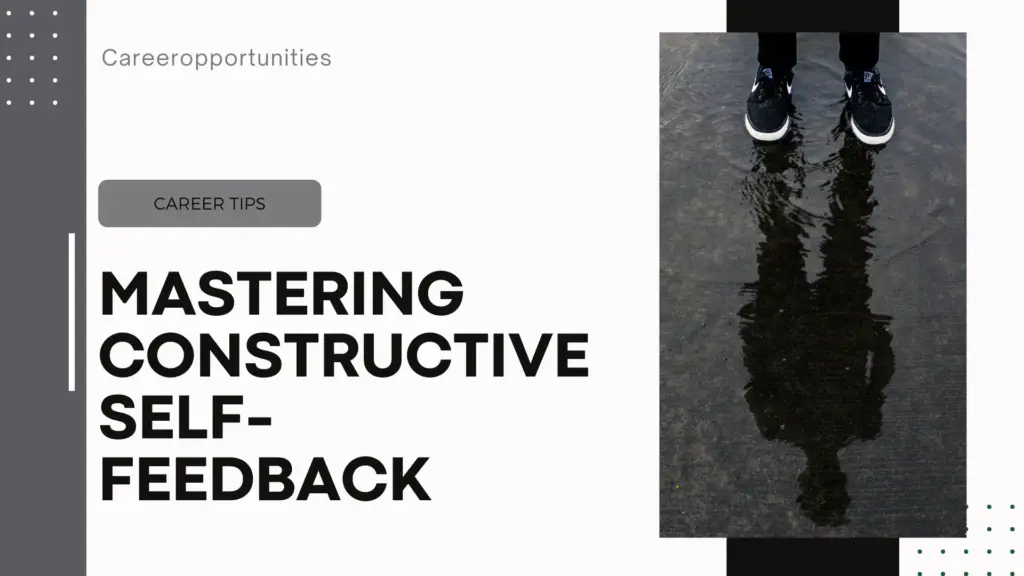
Table of Contents
The ability to evaluate oneself critically and constructively can be a game-changer for professional growth. While external feedback is valuable, learning how to assess yourself without it can be transformative. Constructive self-feedback not only enhances self-awareness but also helps you make immediate improvements without waiting for formal evaluations. Here’s a five-step guide to mastering self-feedback and boosting your career growth independently.
1. Define Clear, Achievable Goals
To give yourself meaningful feedback, start with well-defined goals. Goals set a framework that allows you to measure progress effectively and helps to direct your focus. Identify specific, actionable goals that align with both your career aspirations and the skills you want to develop. For instance, if you aim to enhance your leadership abilities, your goal could be to lead more team initiatives or mentor colleagues.
Tip: Use the SMART criteria—Specific, Measurable, Achievable, Relevant, and Time-bound. For example, instead of setting a general goal like “improve communication,” set a SMART goal such as, “Practice public speaking twice a week for three months to improve presentation skills by 20%.”
2. Track Your Daily Performance
Consistent tracking is the foundation of effective self-feedback. Keep a journal or use a digital tool to log your daily tasks, wins, and areas that need improvement. This approach lets you monitor progress over time, offering a clearer picture of patterns and trends in your performance.
At the end of each week, review your entries to analyze where you’re succeeding and where adjustments are needed. By maintaining a daily log, you have an ongoing record of your journey, which makes self-assessment less overwhelming and more insightful.
💬 Get Paid in Dollars Just by Chatting With Lonely People
Imagine earning daily dollar income from anywhere in the world — no degree, no experience, no interviews — just your phone or laptop.
People are getting paid simply to chat, listen, and keep others company online. This short ebook reveals:
- ✔ Legit platforms that pay in USD
- ✔ How Africans can register & withdraw successfully
- ✔ What to say to keep conversations paid
- ✔ How beginners start with zero experience
Instant download • Works worldwide • Beginner-friendly
Tip: Focus on noting both achievements and challenges. The goal here is to foster self-awareness, so be objective about your strengths and honest about the areas that need improvement.
3. Practice the 360-Degree View
Taking a 360-degree approach to self-feedback involves evaluating your performance from multiple perspectives. Consider how your actions impact not only your tasks but also your colleagues, superiors, and clients. Imagine how they might perceive your performance—this can reveal blind spots and highlight strengths you may not have noticed.
Ask yourself questions like:
- How do my actions contribute to the team’s success?
- If I were my own manager, what feedback would I give myself?
- How would my coworkers describe my work ethic and collaboration skills?
This mindset allows you to assess your actions comprehensively, enhancing empathy and providing insights into how others may view your work.
4. Create a Regular Self-Reflection Routine
Establishing a routine for self-reflection is crucial to building constructive feedback into your personal development. Set aside time each week, or at least once a month, to review your goals, track records, and the lessons learned. This structured approach prevents self-feedback from becoming sporadic and ensures you remain committed to ongoing improvement.
During these sessions, review your progress towards your goals, evaluate recent achievements, and take note of any setbacks. This routine will help you identify trends, refine your goals, and adjust your strategies for continuous growth.
Tip: Try the “Three Whys” approach: For any mistake or accomplishment, ask “Why did this happen?” and dig three layers deep. This technique allows you to explore the root causes behind outcomes and makes your feedback more insightful.
5. Focus on Solutions, Not Just Critiques
Feedback should always lead to improvement. When you identify a shortcoming, resist the urge to dwell on it; instead, brainstorm practical solutions. If you notice that you’re frequently missing deadlines, for example, focus on time management strategies that can help you stay on track.
Make an action plan for each area of improvement, specifying what changes you need to make, which resources or skills to develop, and the timeline for achieving these goals. By maintaining a solutions-oriented mindset, your self-feedback becomes a tool for proactive growth rather than a source of frustration or self-doubt.
Tip: Pair every critique with an actionable step. If you felt you struggled with a presentation, for instance, commit to attending a public speaking workshop. This approach turns weaknesses into catalysts for growth.
Final Thoughts
Constructive self-feedback is a powerful skill that fosters resilience, self-awareness, and continuous improvement. By defining clear goals, tracking performance, adopting a 360-degree perspective, creating a regular reflection routine, and focusing on solutions, you can cultivate an independent feedback loop that empowers you to grow in your career. Remember, feedback isn’t just about identifying what needs to change—it’s about recognizing your accomplishments, building confidence, and driving your own professional development.
For more understanding on this, read this article from FORBES
See also:
Valencia College Global Achievers Scholarship 2025/2026 for International Students: Apply Now!
Coca-Cola Scholarship 2024–25: Apply Now!
The University of Turin Scholarships 2024/25 in Italy: Apply Now
🔥 Want to Make Money Online the Right Way?
Discover how smart people are quietly earning with AI, Email Marketing, CPA, LinkedIn, Online Teaching & Content Creation.
This is not theory — it’s a step-by-step system.
👉 Get the Ebook Now











